How I Broke my Vow to Never Feed Bees Sugar Water
This June, I caught a swarm of wild bees in a swarm box, put them into a horizontal hive that I built in my shed, and they settled into their new lives behind our cabin. I never imagined they might not get enough honey stored away before winter. Click on the video below to hear them buzz (more on what they’re drinking shortly).
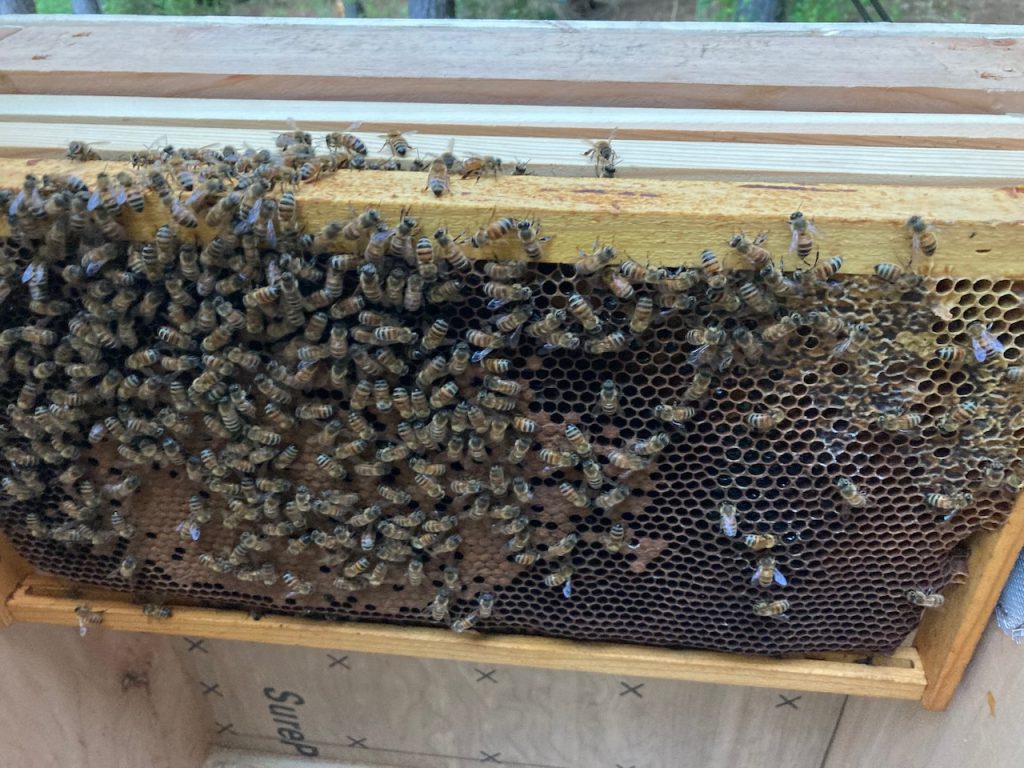
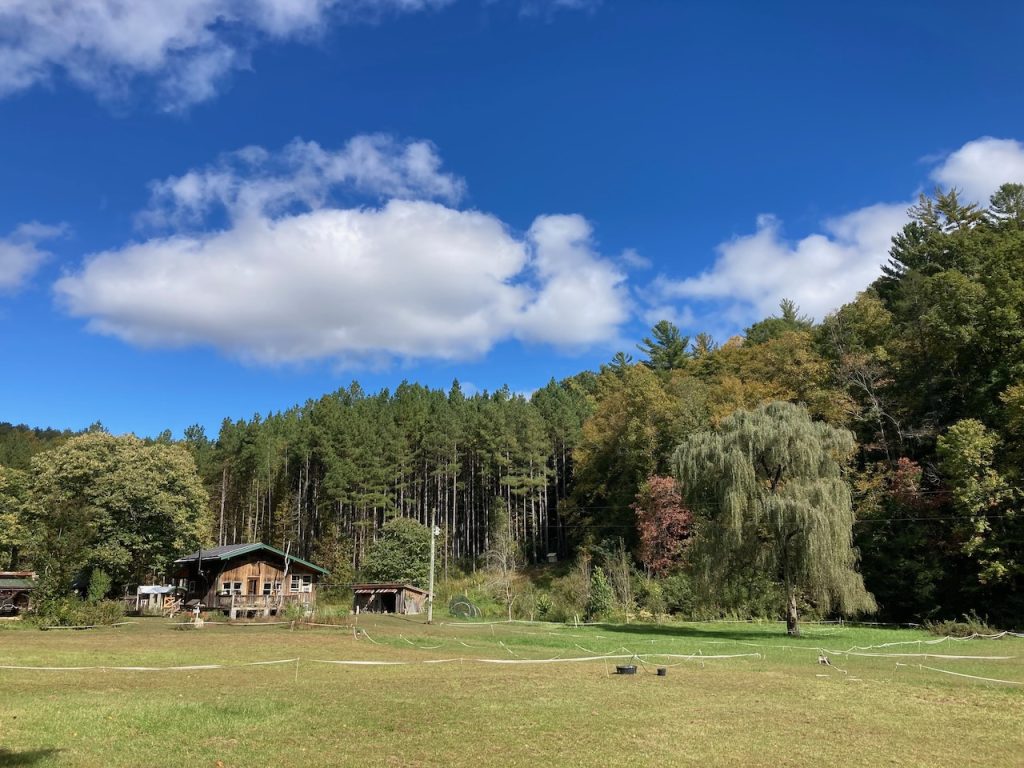
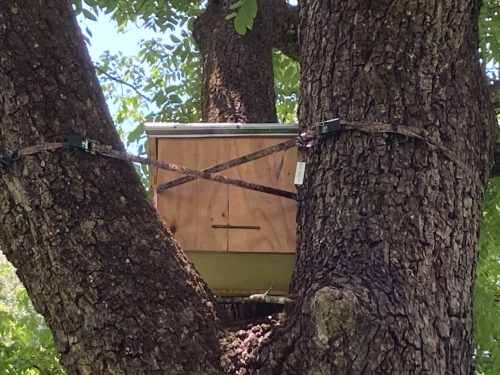
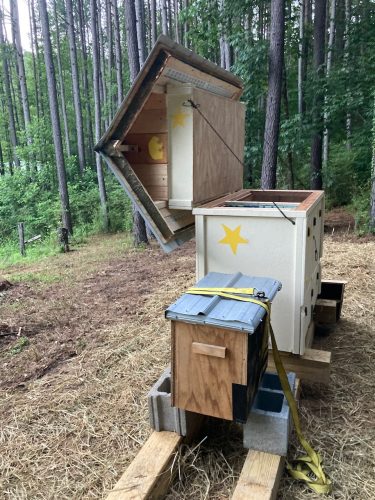
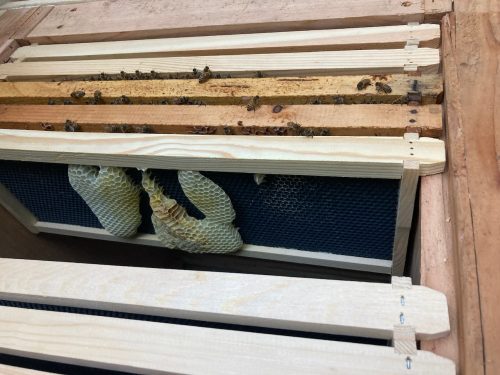
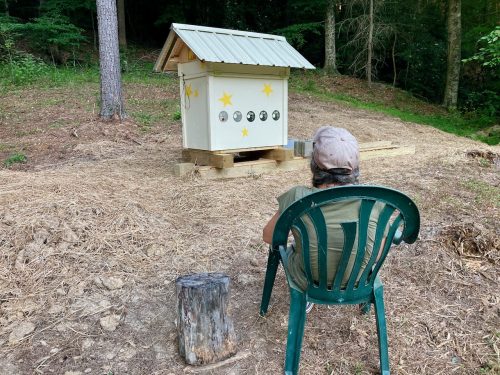
The only rule that I had for the new bees was that I wasn’t going to feed them sugar water so they’d make more honey than Ma Nature intended. Sugar isn’t great for humans and so it’s probably not great for bees. Because they were a young colony, I knew they were going to have to hump it if they were going to grow into a strong colony, complete with comb, honey and brood (that’s fancy bee-talk for baby bees) before winter.
No sugar. They were wild bees, after all.
Hummingbird Feeders
June turned to early July and the bees fed on clover in our hay pasture.
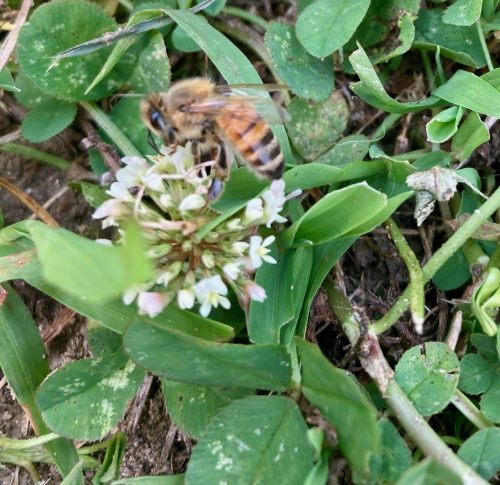
July got hot, and summer overcame Julia and me. The dogs Lucky and Diggity cornered a rat snake. I found a dragonfly eating an eastern tiger tail butterfly and I dug the garlic and potato patches. We went to the dump, I sold my beloved old pickup and one of my game cams snapped a photo of a goofy bear messing with one of our Posted signs.
(Click on the thumbnails for the big snake, garlic, tater and silly bear photos)
August rolled around and the clover quit blooming and when I looked around, the few flowers that were in bloom, like the wild clematis and golden rod, didn’t have bees on them. Oh no. Where were the bees going to get the nectar and pollen they needed for the coming winter?
While all this was going on, the hummingbirds were happily sipping from the feeders my wife Julia and I hung from our porch. They were filled with, yes, sugar water. The same thing I’d sworn I wasn’t going to feed the bees.
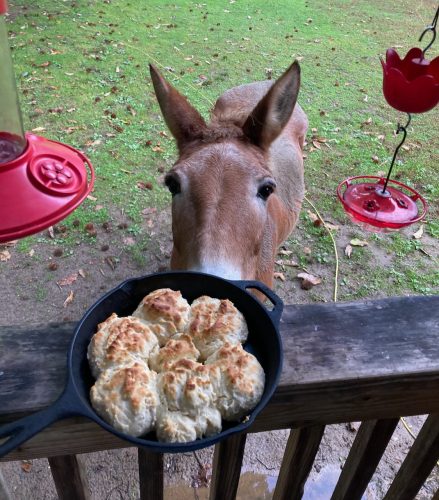
Wild Bees Don’t Need No Sugar
Originally, I didn’t want to feed the bees sugar water because they were wild and I figured they’d gotten through life without cane sugar juice so why start now (okay, honey bees aren’t technically wild. Historical records show they showed up in the New World on a three-ship fleet that arrived in Jamestown, Virginia in April 1622.) My thinking was pure sugar was as bad for bees as it was for people.
Then again, if that was the case, why was sugar water bad for the bees but okay for the hummingbirds?
About that time, the first honeybees showed up at the hummingbird feeder. They stuck their long, tiny tongues and sipped away like miniature versions of honeybees. I looked around and noticed that the classic summer flowers that were blooming in the yard – the cosmos, sunflowers and zinnias – didn’t have bees on them. It’s funny how, once you get bees, you suddenly start noticing what’s blooming around you and divide plants into two types – Flowers Bees Like and Flower Bees Don’t Like.
We had entered the Season of Flowers Bees Don’t like, known to beekeepers as the dearth, the time of the year when there’s just not much for a honeybee to eat.
That’s when I caved in and Broke Rule Number 2 (the one about no sugar water for the bees).
From Hummingbird Nectar to Bee Sugar Water
It started with a tiny sip. During peak hummingbird season, I make a quart of hummingbird nectar at a time (one part sugar to three parts water). I felt sorry for the bees, so I filled a one-quart Ziplock bag with hummer nectar, put the baggie on a white plate, opened my bee hive and set the plate and bag of honey water on the bottom of the bee hive.
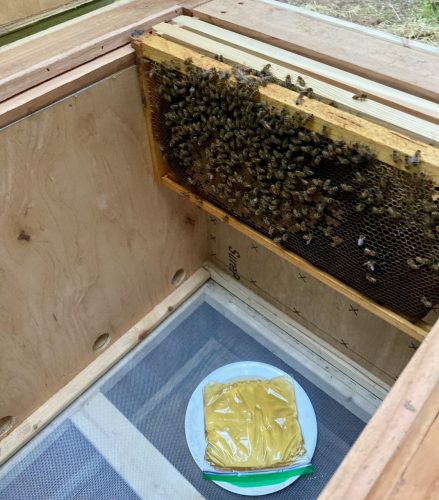
Then I punched a few holes in the baggie so the sugar water could flow out and the first bee landed on it like she’s won the lottery without even knowing she’d entered it. More and more bees pounced on the sugary gift and I shut the top of the hive as quickly as I could before the bees swarmed me.
Forty Pounds of Honey
A few days later, I opened the hive and checked on my baggie. It was empty. When I looked at the baby colony of bees (remember, I caught them in June and they’d only started setting up their home in my hive), I noticed they hadn’t built much comb.
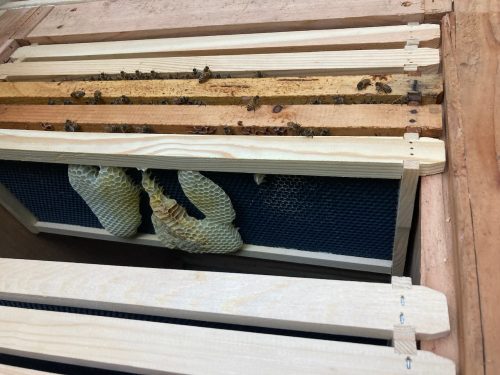
That wasn’t good news. Honey comb is where bees story honey, raise their young and store their winter stores. It takes bees a lot of energy to build comb, about eight times as much as it does for them to make honey. And then they have to fill that comb with honey. It takes a colony of bees about forty pounds of honey to get through the winter in our area (western North Carolina). From the look of it, my bees had a long way to go. I reckoned they had five pounds of honey on hand.
The dearth was hitting my bees hard and I started having real doubts that the colony was going to survive its first winter.
More Sugar Water
So, a few days later, I put another baggie of sugar water into the hive. The bees drained it and begged me for more (okay, bees don’t beg but they sure swirled around my head like they were pleading for more hummingbird nectar sugar water.) At this point, I was rooting so hard for their survival that there was no way I could wean them off sugar water. Instead, I upped my delivery system.
I filled a 1/2 pint juice jar full of sugar water, screwed on the lid, punched it full of holes, turned it upside down on a plate and, voila, instant sugar water feeder. Instead of putting this improvised feeder into the hive, I set it on a post in front of the hive. The bees found it, polished it off in a day and asked for more.
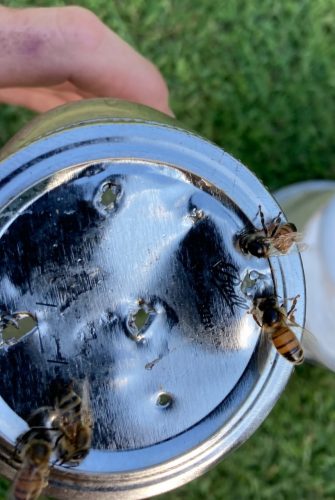
You can see where this story is going. I refilled the 1/2 pint jar with sugar water, the bees polished it off and found that I’d run out of sugar. So, I bought another 5-lb bag. This time, I mixed the sugar 1:1 (one part sugar to one part water). The bees polished off this super-charged sugar water so fast I up-sized to one-quart jars. Which of course meant, the next time I went to the store, I bought ten pounds of sugar.
Ten pounds of sugar was enough for a gallon of sugar which the bees slurped in a few days. So I went commercial candy-making grade.
Twenty Five Bags of Sugar
Have you ever bought a twenty-five pound bag of sugar? You should, if for no other reason than to know what it’s like to hold the equivalent of a caloric Niagara Falls. The marketers know this so they break the stuff into relatable servings. The bag I bought had a picture of a spoon on it that had “only 30 calories per serving” written above it.
Come on? How bad is that?
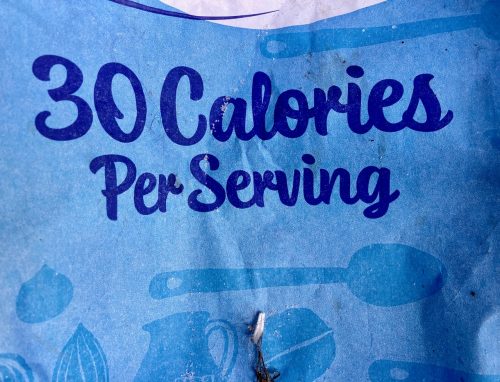
Well, it’s bad enough to kill thousands of people every year thanks to diabetes, obesity, tooth decay and overactive children. Which is exactly why I wasn’t feeding it to my bees.
And yet, that twenty-five pound bag of sugar made a most satisfying “thunk” as I plunked it into my shopping buggy and hauled it to the check out.
I went through the self-checkout so none of my friends would see my buying this (I like to brag to my friends that Julia and I sweeten our food with honey which means we don’t buy sugar) and, half an hour later, found myself mixing up my first industrial sized batch of sugar water.
Goin’ Industrial
I got out my two-gallon pressure cooker, filled it with ten pounds of sugar and a gallon of water and brought the whole lot to a slow boil on the stove. Half an hour later, I was the proud owner my first two gallons of super strength sugar water. It was thick as clear corn syrup and the bees loved it.
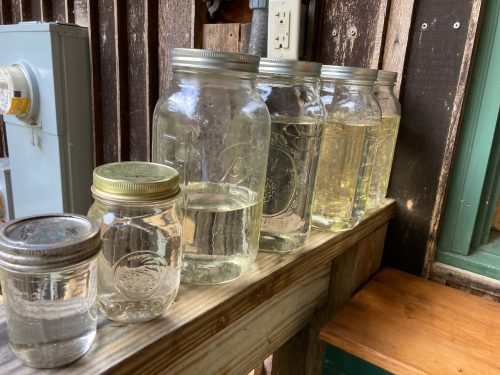
Every morning, I brought them a jar of this clear nectar and I swear they met me gleefully rubbing their tiny front legs (hands? arms?) together when they met me. Occasionally one would land on me and walk up my arm, like it was looking for the source of mysterious meals I was bringing it. This never made me nervous. The bees seemed well-tempered.
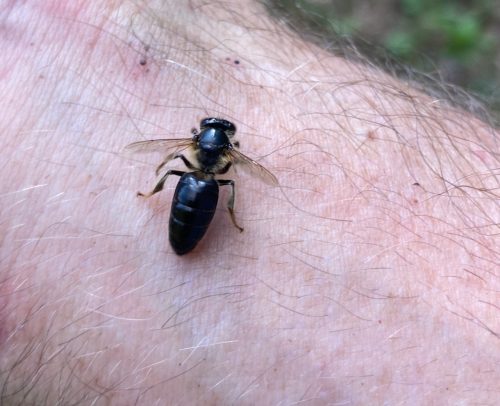
Life at the Bee Safari Park
I’d set my offering on a fence post in front of the hive and watch as the bees buzzed in. They circled and landed before they drank.They crammed there faces hard up against the feeder, like they were facing off on the line of scrimmage. They had wrestling matches in the syrupy goop. Sometimes, when they were all lined up for a drink, I felt like I was looking at a watering hole at a miniature safari park.
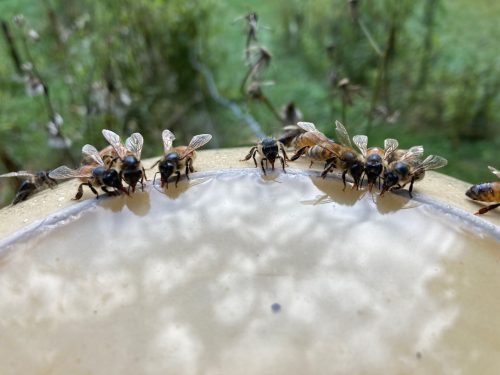
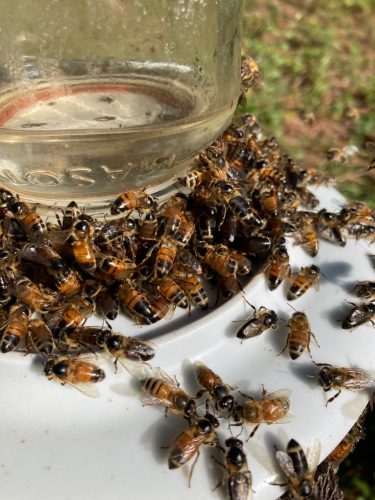
I was thrilled and my bees were so thrilled that they went through that twenty-five pound bag of sugar in two weeks. So I had to go back to the store for more.
Anything for the bees during the dearth, right?
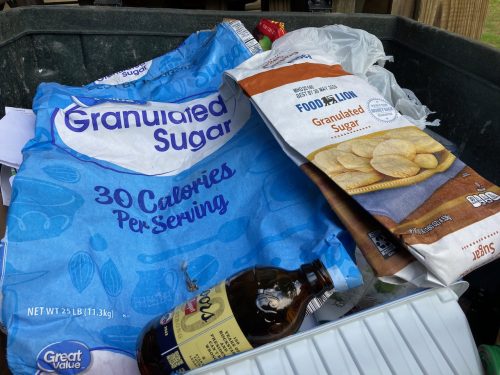
You can see where this is going. I bought another twenty five pound sack of sugar, which lasted ten days, and then I went back for more.
More Jars
I couldn’t feed the sugar water from a single one-quart canning jar so upgraded to two, one-quart jars. At this point, the bees were slurping half a gallon of sugar water every day. And they were getting addicted. When I went to feed them their All-American sugary breakfast, they met me, circling the post where I set the sugar water, like high speed junkies that just broke the vow to stay clean. They started buzzing me, wondering where the smack was, while, back on the porch, the hummingbird feeders (remember, it started with hummingbird nectar) occasionally swung dry in the breeze.
I set up my chair in front of the front opening of the bee hive and watched the bees come and go. None of them had pollen on their back feet but all of them had swollen bellies, presumably full of sugar water. I just stared and smiled. That’s the way it goes with junkies.
The Sugar Truce
August slipped into September. The nights started cooling down and on September 15, I fired up the wood stove for the first time this season.
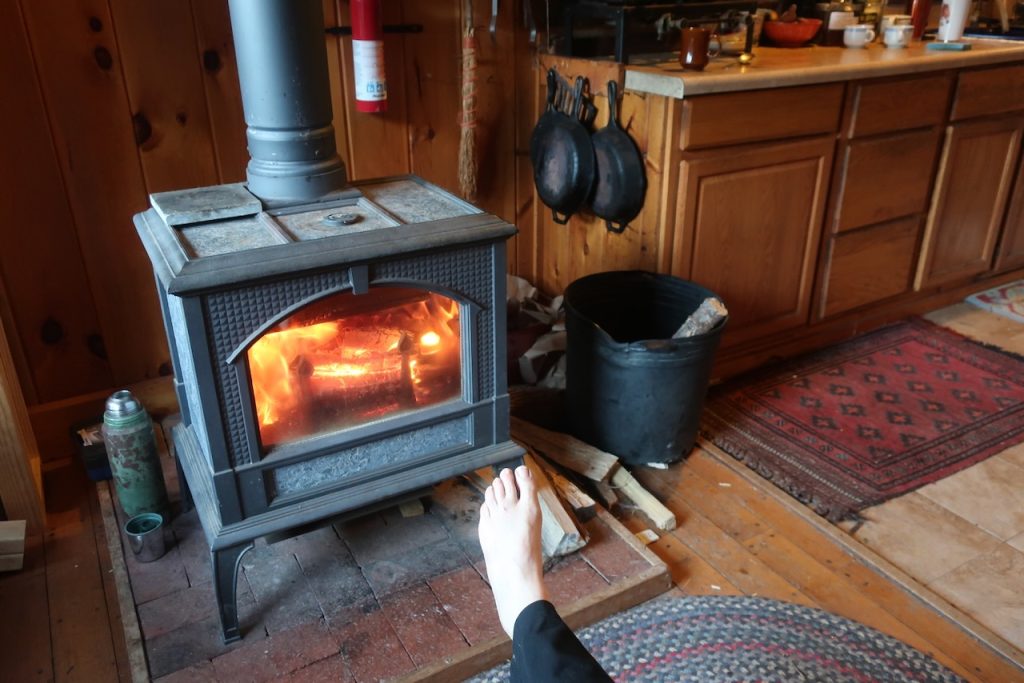
The fall aster started blooming and the volunteer marigold next to the barn burst out in giant orange blooms. Purple blooms covered the ironweed next to the driveway. None of the plants attracted any bees.
Every morning, I’d feed the bees sugar water (I’d bought over 100 pounds of sugar at this point), and spent a few minutes sitting in front of the hive, watching the ladies come and go. One day, I noticed that a few of them came back to the hive with orange balls of pollen on their back feet. I looked around and didn’t see any orange flowers (or flowers with orange pollen) blooming. A few days later, the pollen on the bees’ back legs changed from orange to cream-colored. Not long after, the pollen on the bees’ legs changed to yellow and I saw the bees on the fall aster. For reasons only known to bees, the aster, which they’d ignored in mid-September, sure got their attention in October. The dearth was over.
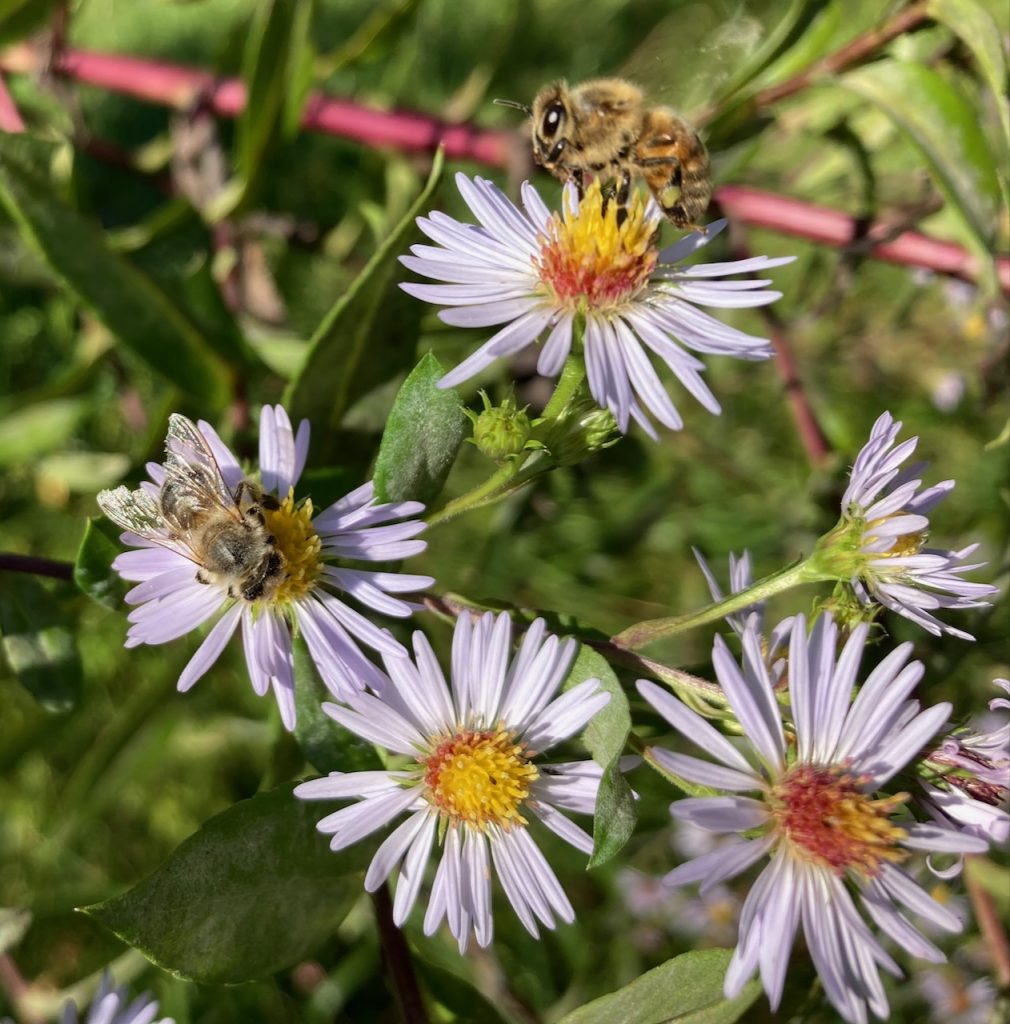
So Here we Are
Now it’s mid-October. The hummingbirds have deserted the feeders for central America, and night time temperatures are dipping into the upper thirties. This week, Julia and I cooked our first hot breakfast of the season on our wood stove. The bees, instead of bum-rushing me first thing in the day for sugar water, are only coming out of their hive around ten o’clock. They move sluggish, like bears after a long sleep. I don’t exactly know what’s going on with them but from what I’ve read, they’re setting up their winter nest.
Peace has returned to the hive. It reminds me of the early days with my colony, where I’d just installed them and watched them come and go from the patches of clover in our hay field. Those were calm times, with plenty of nectar and winter far away. Now,the official start of winter is only two months away.
A few days ago, I put on my bee suit and looked into the hive. I was happy to see the bee colony has grown to a size that I think can survive winter.
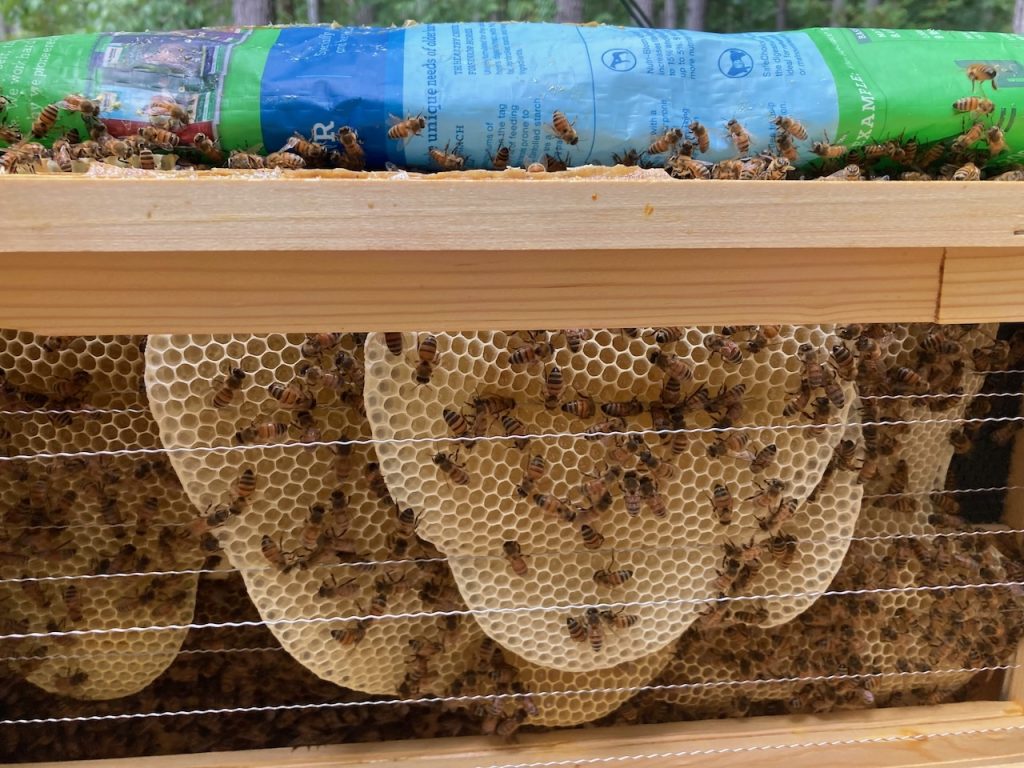
They don’t mob me as much when I bring them sugar water and they’re sure drinking less of it, only about a quart every other day. They’re settling down, like they’ve put away plenty of honey and pollen for the winter ahead and I’ve gone back to watching them come and go from the hive entrance.
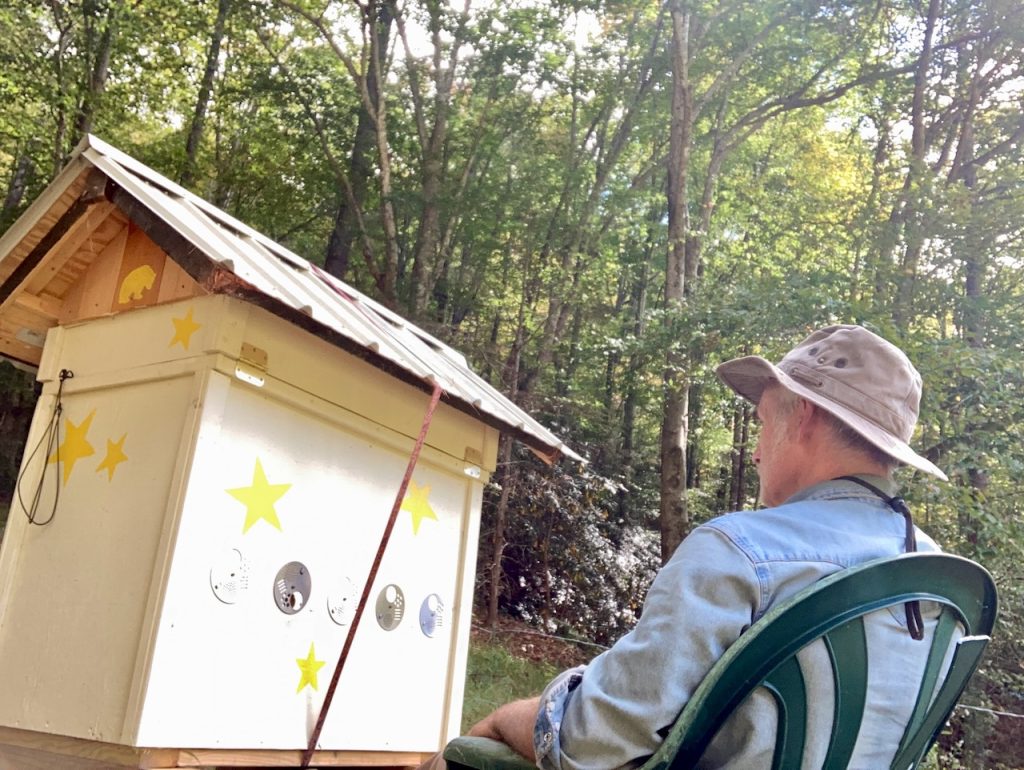
Wild Bees
All is well and natural as can be. I watch the bees crawl into and out of the hive. Most of them have little yellow balls of pollen on their back feet and a few fly in straight off the clump of asters that grows downhill from the hive. A few are sticky, though, with massively distended stomachs, which tells me they’ve just had a long drink of sugar water.
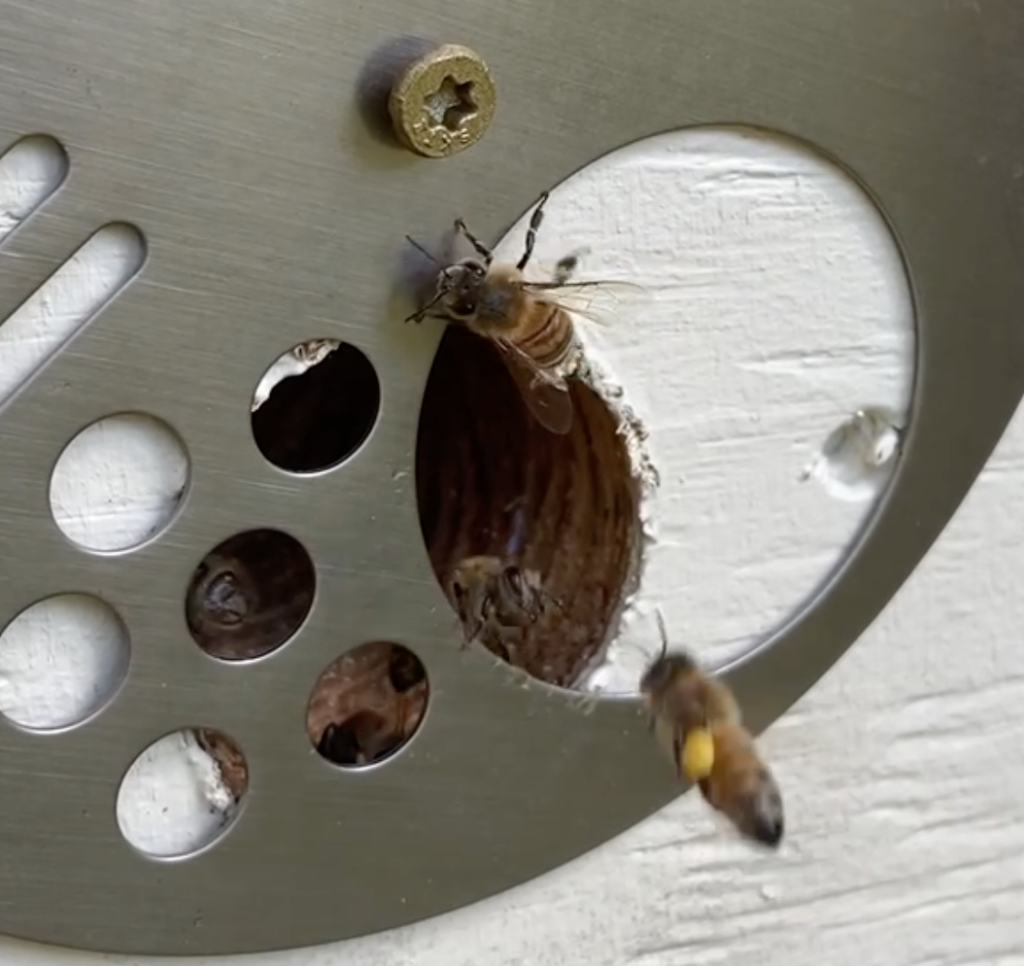
The bees are gonna be okay. They are, after all, wild bees

What’s Your Sugar Water Story?
Are you a beekeeper? Do the honeybees swarm your nectar feeder? What are your thoughts to feed or not feed sugar water. I’d love to hear from you in the Comments section below.
Get A Free Copy of my New Photo Book 19 Million Mule Steps
I’d love to give you a free copy of my just-released 134-page photo book 19 Million Mule Steps. The book contains a lot of the material that didn’t fit into my upcoming book Two Mules to Triumph, about my 7 month, 2,300 mile Long Ride from North Carolina to Idaho with my mules Brick and Cracker.
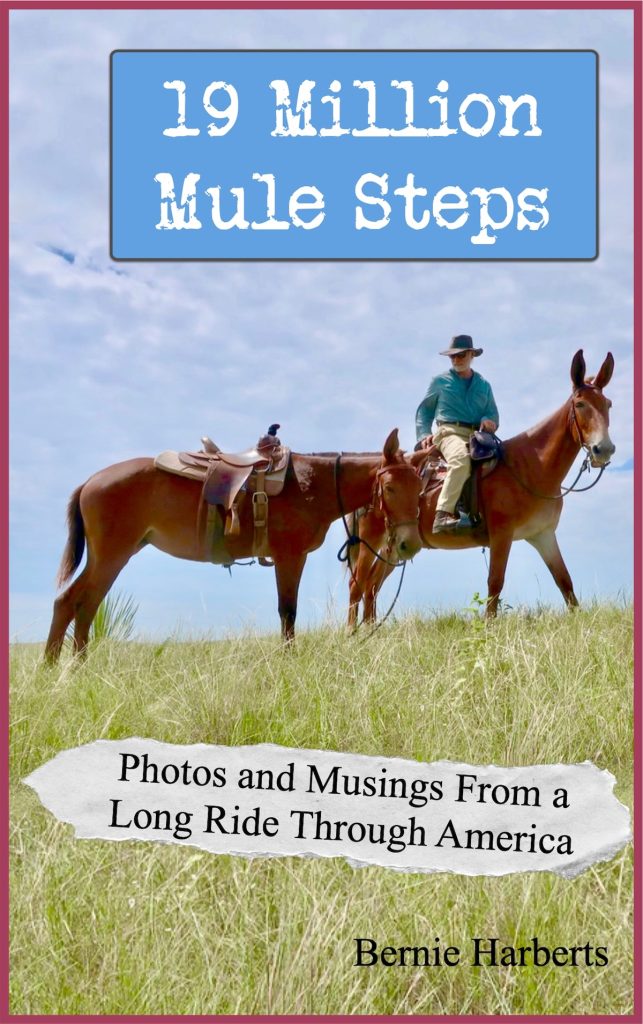
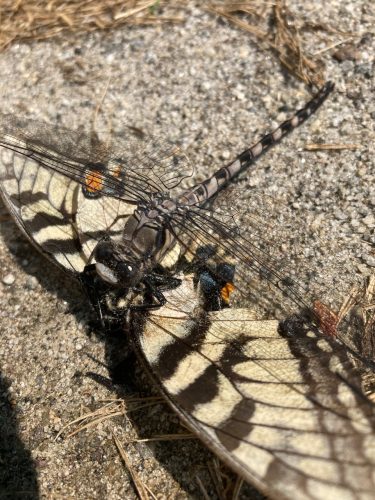
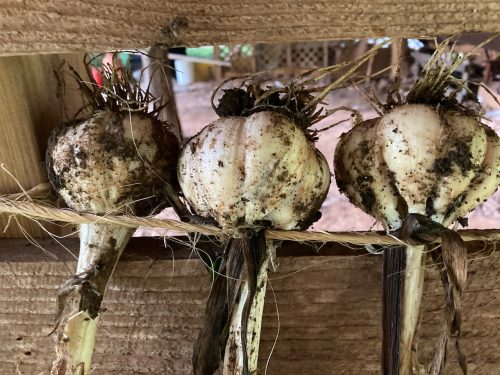
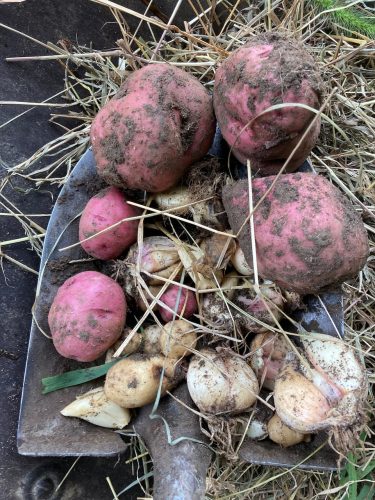
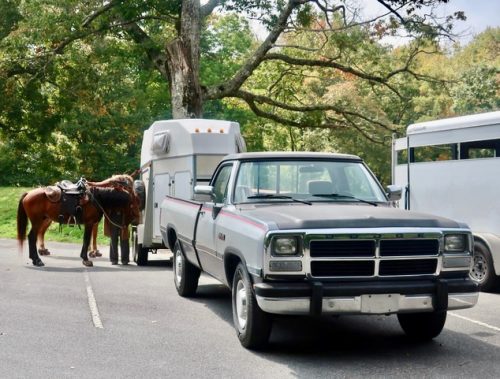
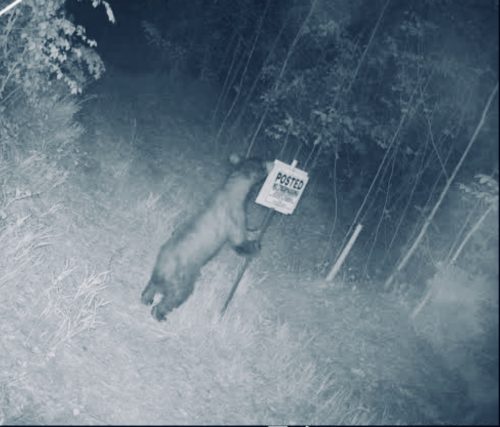
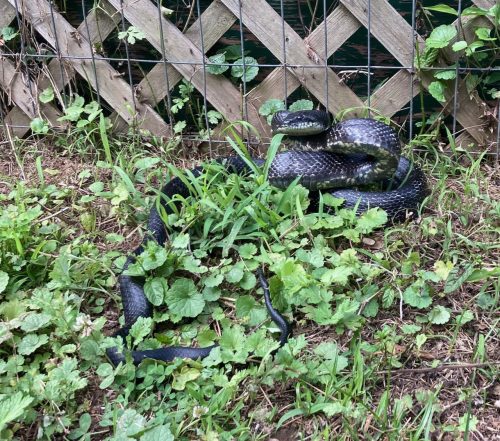

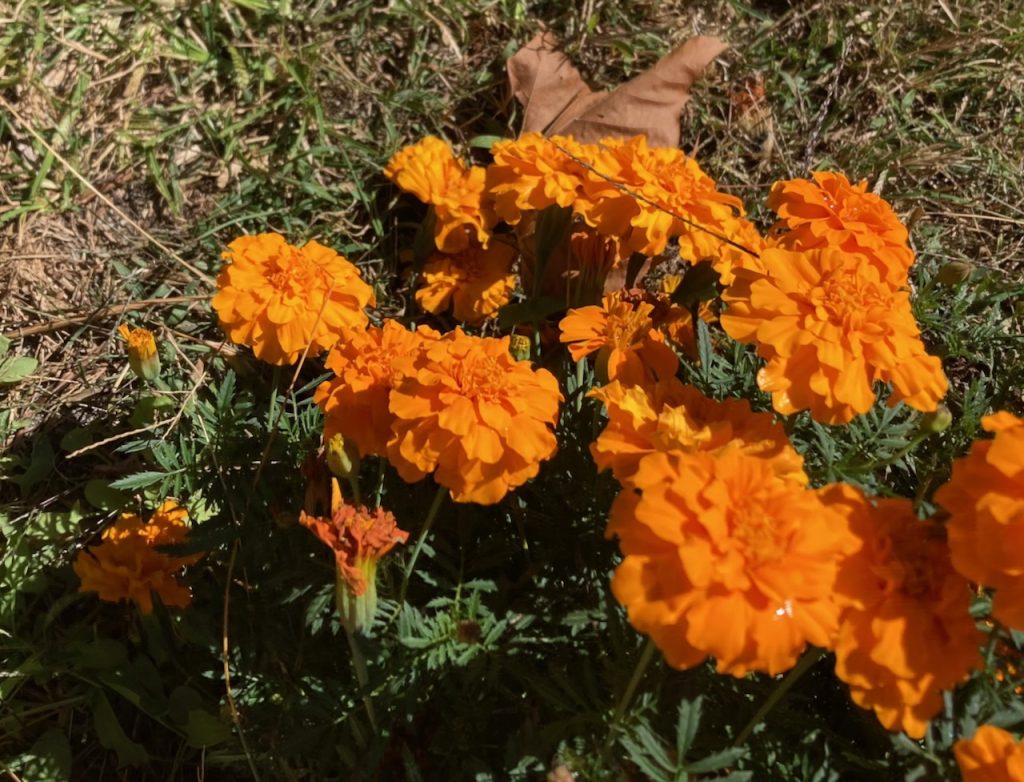
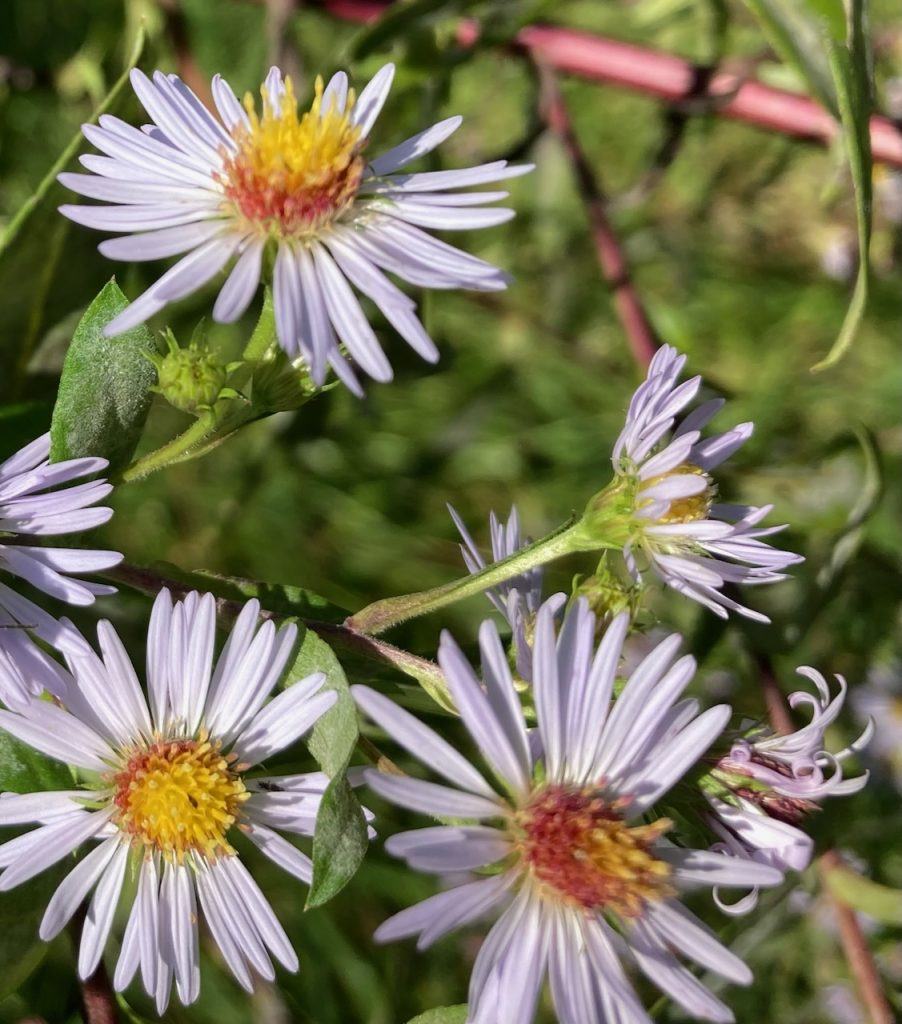
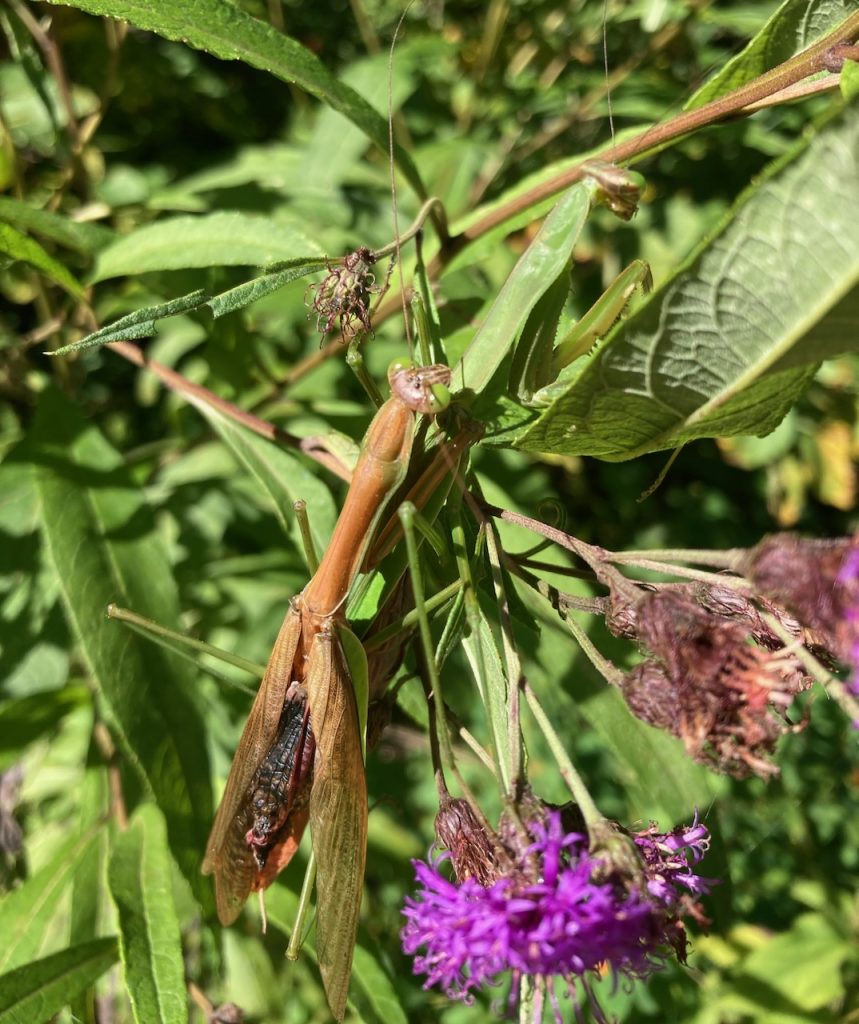
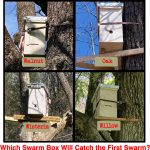
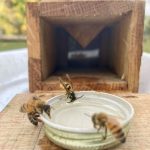
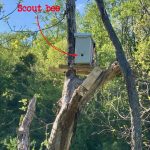

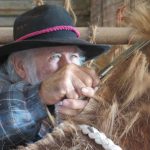



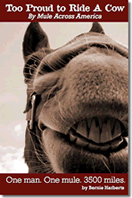
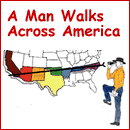

Just had a chance to review what I told my wife Babette about your bee-keeping adventures. Happily I got most of the salient facts right…
What really got my attention though was the thing about “overactive children” being one of the leading causes of premature death in the country. Babette suggested you amend that to overactive /school/ children. She should know. It’s an international problem, seemingly 😉 #humour
In fairness to bees around the world (which live off honey, right?) I say she should run a test: feed half her young students honey and half sugar and see if there’s a noticeable difference. Then again, she may not survive the experiment. Let me know how it goes!
I love reading your short stories of life at the cabin! My mom kept bees, starting in the mid to late 70’s. I’m slightly allergic so mostly worked with finishing the product. We had a huge centrifuge set up in the middle of the kitchen. One April 1st evening Barbara went on a date leaving Sam and I alone with our imaginations. We drizzled honey on the floor from the door to her bedroom. Decided the prank needed more so flipped the circuit breaker so there was no light. She kept a flashlight in her bureau drawer so we removed the whole bureau and waited up in Sam’s loft above the living room, with a great view of the action to come. Mom came home and realized the lights were out and headed to get the flashlight, we almost immediately heard “Schlock, shlock, shlock” as she crossed the kitchen. We started giggling but tried to keep it quiet. At this point she was on to us but didn’t realize there was more. She took off her shoes and went to get the flashlight and found that the whole bureau was missing. that is when she lost it laughing and Sam and I did, as well! We made her find her bureau in the dark before we came down (it was in the living room) and all convulsed laughing. Sam and I had one hell of a mess to clean up the next day but it was absolutely worth it! I hope you enjoys your bees and the fruits of their labor as much as we did!
Hi Lily, Holy crap! That is one of the funniest bee stories EVER, right down to the “Schlock, shlock, shlock” of Barbara walking across the honey-covered floor. Julia and I laughed our heads off. Thanks for sharing!